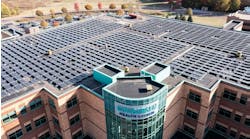DOE’s Jigar Shah: Microgrids Provide ‘Something for Everyone’
Nearly a decade ago, the finance community asked many questions about the viability of microgrids. But that changed after the industry did some “noodling” of the technologies involved, and microgrids began providing important benefits to residents, businesses and utilities.
That was the message from Jigar Shah, head of the U.S. Department of Energy’s (DOE) Loan Programs Office, which has about $44 billion in available lending authority. He spoke with Microgrid Knowledge during the Nov. 9 Dervos conference in Brooklyn, New York, organized by the Distributed Energy Resources (DER) Task Force, a group of DER experts and enthusiasts.
Initially, the finance community had questions about microgrids such as, “How do you make it work? What's the software look like? What's the hardware look like? How do they work together?” he said. “What's the lowest cost? Are the different components beefy enough?”
For many years, the industry has been on a quest to answer those questions and improve microgrids – with better solar inverters, the ability to island and other features, Shah said. Industry members did a lot of experimenting to improve the technology – and succeeded.
Wanted: extraordinary microgrids
“Now that we have these extraordinary microgrids that we've practiced on, it turns out that a lot of people want those features even in a grid-connected setting,” Shah said.
While Shah now helps microgrid and other DER developers move their projects forward, his career began when he made a splash in the solar world.
An immigrant who grew up in an area of India that had no electricity, Shah founded SunEdison in the U.S., a company that helped propel solar on its meteoric growth path with “no money-down” solar financing. He then founded Generate Capital, which helps developers finance and operate sustainable infrastructure projects.
When Wall Street doesn’t show up, the DOE steps in
At the DOE, he continues his mission of getting as much renewable energy deployed as possible, this time using the energy department’s lending authority, which plays an important role when Wall Street won’t finance projects.
Wall Street has liked the microgrid industry’s technology improvements. But that hasn’t been the only driver of the industry’s forward movement. Pain in the energy industry has also spurred growth, Shah said.
Industry pain yields microgrid opportunities
“People desperately need microgrids,” he said. “I talked to a hyperscale data center company that said nobody wants data centers now because there's no excess electricity left in the country. The only way they’re going to be able to build this thing is to create a microgrid.”
Interconnection challenges also plague electric vehicle charging companies, which may have to wait five years for a connection.
“You know, if they want to get interconnected faster, guess what they're going to do? Microgrids,” Shah said.
People seek alternatives to diesel backup
In addition, people want resilience when the power goes out, and they want to know if there’s an alternative to diesel- or gas-powered generators. Thanks to the industry’s efforts to improve microgrids, the answer is yes.
“It turns out that all this noodling that we've been cooking for decades was valuable for everyday Americans who don't want to necessarily disconnect from the grid but do want a resilient solution,” Shah said.
Microgrid providers old and new
And no longer are just startup companies providing the solutions. Companies that have been around for 100 years are now in the microgrid space, Shah said. They’re providing numerous benefits, including full warranties on the performance of their products.
“So now there’s something for everyone,” he said.
The DOE loan office can help provide that something under the right circumstances.
“We fill in the gaps when commercial debt won't show up to the party,” Shah said.
That’s especially true for community microgrids. Shah is fielding requests from villages in Alaska and wildfire-prone communities. In addition, he’s responding to inquiries from commercial and industrial project developers who aim to create emergency shelters or resilient fire stations.
Shah is passionate about helping move these projects along, and he is excited about the technologies that can help meet microgrid customers’ needs. New nuclear options and battery chemistries are among those technologies.
“The actual trend line for nuclear is very strong,” he said.
New technologies hold promise
Nuclear options include traditional nuclear plants, small modular reactors and the latest technology, nuclear batteries or microreactors. The nuclear batteries are about the size of a table, range in size from 1 MW to 10 MW, come prefueled and don’t need to be refueled for about 25 years – in which case they’d be sent back to the factory, not refueled on-site. They’re small, modular and cost-effective, he said.
New battery chemistries also provide benefits to microgrid operators, utilities and utility customers. Some have no critical minerals in them and can operate longer than traditional lithium-ion batteries without being recharged, Shah said.
For example, on Aug. 31, Eos Energy Enterprises, which produces zinc-powered, long-duration storage, received from Shah’s office a conditional commitment for a loan guarantee that is expected to fund 80% of the company’s expansion in Pennsylvania.
Commercializing great ideas
With the benefits of the Inflation Reduction Act (IRA) and other federal initiatives, such technologies are more likely to be commercialized. During a panel discussion, “Clean Energy Abundance” at the Dervos conference, Shah said the U.S. dropped the ball for 10 years on developing new technologies.
“There's so many great ideas out there, but we were taking technologies that were at level five and saying, ‘We're going to stop there and let China or Europe finish the job.’” That has all changed. “With the [IRA and Bipartisan Infrastructure Law] being passed, we are now in the driver's seat. We're going to get all these technologies across the bridge,” Shah said.
Shah’s solar vow
In the meantime, he’s going to fill every empty roof with solar, he vowed during the panel discussion
How?
“I have worked in this industry for 20-plus years,” Shah said during the interview with Microgrid Knowledge. “I have worked hard every day to figure out that next iteration. Every two years, we have come up with something new, something different.”
And that’s what he’s going to keep doing – until all those roofs are filled with solar.








